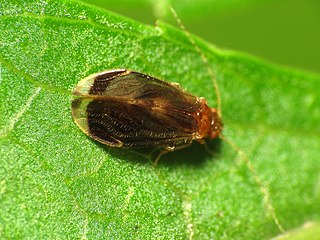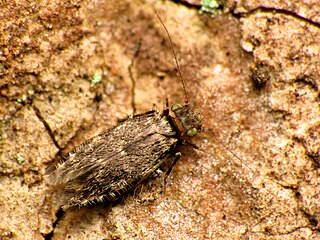
Psocomorpha is a suborder of barklice, booklice, and parasitic lice in the order Psocodea. There are more than 20 families and 5,300 described species in Psocomorpha.

Trogiomorpha is one of the three major suborders of barklice, booklice, and parasitic lice in the order Psocodea, alongside Troctomorpha and Psocomorpha. There are about 8 families and more than 430 described species in Trogiomorpha. Trogiomorpha is widely agreed to be earliest diverging of the three suborders, and retains the most primitive characteristics.

Troctomorpha is one of the three major suborders of Psocodea (barklice, booklice, and parasitic lice), alongside Psocomorpha and Trogiomorpha. There are more than 30 families and 5,800 described species in Troctomorpha. The order includes parasitic lice, which are most closely related to the booklice family Liposcelididae.

Caeciliusetae is an infraorder of Psocodea in the suborder Psocomorpha. There are about 6 families and more than 1,300 described species in Caeciliusetae.
Asiopsocidae is a family of Psocodea belonging to the infraorder Caeciliusetae. The family is composed of 14 known species of barklice in three genera: Asiopsocus, Notiopsocus, and Pronotiopsocus. One species from each genus has been found in the United States.
Archipsocidae is a family of barklice of the order Psocodea belonging to the suborder Psocomorpha. Members of the family are characterized by their reduced wing venation. Some species are viviparous. The family includes about 80 species in five genera.

Caeciliusidae is a family of Psocodea belonging to the suborder Psocomorpha. The family was once named Caeciliidae, but the latter name was changed because of homonymy with the amphibian family Caeciliidae. The subfamily Paracaeciliinae was formerly in Caeciliusidae, but it has been elevated to family rank, Paracaeciliidae.

Homilopscocidea is an infraorder of Psocoptera. It is probably a paraphyletic group, still in use for lack of a better solution. There are about 7 families and more than 1,200 described species in Homilopsocidea.
Epipsocidae is an insect family of Psocodea belonging to the suborder Psocomorpha, that includes, among others, the genera Bertkauia, Epipsocus, Epipsocopsis, Goja, and the New Guinean endemic Dicropsocus. It includes 16 genera with more than 140 species. The only European species in the family is the apterous Bertkauia lucifuga. Like the other members of the infraorder Epipsocetae, they have a labrum with two sclerotized ridges. Epipsocids are barklice found primarily in tropical regions, and one of their distinguishing characteristics is the hairy ventral surface of the forewing.
Prionoglarididae is a family of the order Psocodea that are barklice characterized by the reduction or simplification of the lacinia in adults and the specialised form of the male genitalia. It contains the only known genus of animals, Neotrogla, where females possess a penis-like organ and take on typical male sex roles.

Lepidopsocidae are an insect family of bark lice belonging to the suborder Trogiomorpha. Colloquially, Lepidopsocidae are referred to as the Scaly-winged Barklice. There are more than 220 species described worldwide. Phylogenetic DNA analysis of relationships between families in Trogiomorpha propose that Lepidopsocidae is monophyletic, meaning that the taxa within all share a common ancestor. This is supported morphologically by the presence of scales and setae covering the body and forewings of Lepodopsocids. Sister families of Lepidoposcidae include Trogiidae and Psoquillidae.

Epipsocetae is an infraorder of psocids in the order Psocodea. There are about 5 families and more than 480 described species in Epipsocetae.

Psyllipsocidae is a family of cave barklice in the order Psocodea. There are about 7 genera and more than 70 described species in Psyllipsocidae.
Psoquillidae is a family of bird nest barklice in the order Psocodea. There are about 8 genera and more than 30 described species in Psoquillidae.
Psyllipsocus is a genus of cave barklice in the family Psyllipsocidae. There are more than 50 described species in Psyllipsocus.
Electrentomidae is an extinct family of barklice, booklice, and parasitic lice in the order Psocodea. There are about six genera and seven described species in Electrentomidae. The family was synonymsed with the extant family Manicapsocidae in 2003 without discussion, with a prior proposal in 1972, but Azar et al, 2017, stated that "we consider herein [Electrentomidae and Manicapsocidae] apart, because a cladistic phylogenetic analysis is needed prior to taking such important decision for these groups."

Paracaeciliidae is a family of bark lice in the order Psocodea. There are about 5 genera and more than 100 described species in Paracaeciliidae.
Protroctopsocidae is a family of psocids in the order Psocodea. There are at least four genera and about five described species in Protroctopsocidae.

Nanopsocetae is one of two major divisions of Troctomorpha in the Psocoptera, alongside Amphientometae. There are more than 20 families and 5,200 described species in Nanopsocetae.

Amphientometae is an infraorder of psocids in the order Psocoptera. There are about 7 families and at least 230 described species in Amphientometae.










